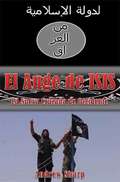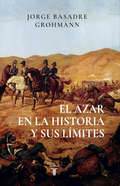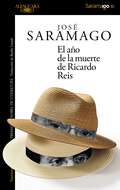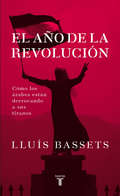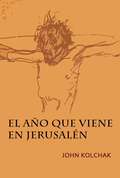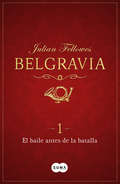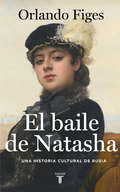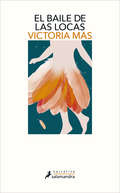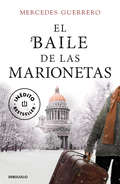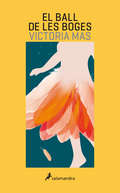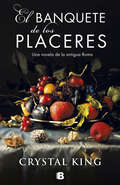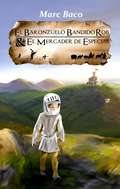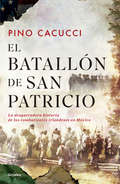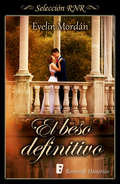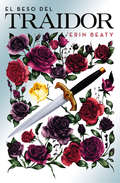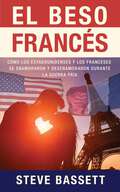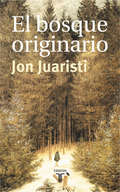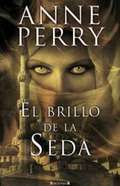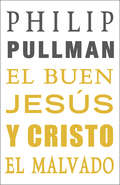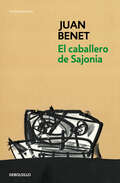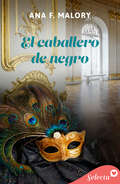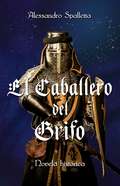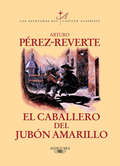- Table View
- List View
El auge de ISIS La nueva cruzada de Occidente
by Andrew Sharp Andrea Lorca LópezDescripción del libro: ISIS ha conmocionado al mundo con su terror y brutalidad. Este libro explora las bases de la organización terrorista ISIS/IS cuyas violentas y sorprendentes victorias han galvanizado al mundo. Esta obra no solo pretende contar la trama de su historia sino, y quizás más importante, explicar su financiamiento, liderazgo, motivaciones y metas y visión finales a través de una perspectiva inteligente y razonada que examina en qué fracasó el liderazgo occidental y los cálculos cínicos que a menudo se hicieron. Irónicamente, muchas de esas decisiones no solo dañaron las relaciones con el mundo árabe sino - como los lectores atentos descubrirán - esas políticas perjudicaron también a sus naciones de origen. Este libro también examina la historia de Oriente Medio a través de los ojos de sus habitantes en sus relaciones con occidente; y defiende la idea de que entender a nuestros rivales es una señal de fortaleza, no de debilidad. Durante la obra se hacen constantes referencias y comparaciones con eventos históricos del pasado para recordar a los lectores la importancia de aprender de la historia y sus características evolutivas. Este libro concluye con recomendaciones meditadas acerca de cómo debería responder Occidente al tumulto de Oriente Medio además de proyecciones sobre los resultados más probables.
El azar en la historia y sus limites
by Jorge Basadre Grohmann«Basadre escribe la historia, pero también la hace. Es un hombre que vivió la República y se metió en el corazón de sus problemas». Ernesto Yepes del Castillo La conmemoración del Bicentenario de la Independencia del Perú sirve de escenario propicio para la reedición de esta obra del historiador Jorge Basadre. A punto de cumplir medio siglo de haber sido publicada, El azar en la historia y sus límites. Con un apéndice: La serie de probabilidades dentro de la Emancipación peruana profundiza en ese complejo periodo de la historia patria y extrae lecciones que se proyectan en nuestro presente. Mientras que la primera parte del libro explora la posibilidad del azar en el devenir histórico, la parte adicional y más extensa está dedicada a la Independencia peruana: la erosión del Imperio hispánico en América; las razones del retardo independentista; el examen de la aristocracia criolla; la comparación de la Revolución emancipadora con la Revolución Francesa; las tensiones externas e internas bajo las cuales empezó la vida del Perú republicano; el Estado empírico y el abismo social. Un libro clave para comprender, a dos siglos de distancia, los albores de nuestra historia republicana.
El año de la muerte de Ricardo Reis
by José SaramagoUna lúcida meditación, a través de un poeta y una ciudad, sobre el sentido de toda una época. A fines de 1935, cuando acaba de fallecer Fernando Pessoa, llega al puerto de Lisboa un barco inglés, Highland Brigade, en el que ha viajado, desde Brasil, Ricardo Reis, uno de los heterónimos del gran poeta portugués. A lo largo de nueve meses cruciales en la historia de Europa, durante los que estalla la guerra de España y se produce la intervención italiana en Abisinia, asistiremos a la última etapa de la vida de Ricardo Reis, en diálogo con el espíritu de Fernando Pessoa que acude a visitarle desde el cementerio en los momentos más inesperados. Es la época de las plumas estilográficas, de las radios Pilot, de las Juventudes Hitlerianas, de los topolinos, en una Lisboa atlántica cuya atmósfera envolvente se convierte en el verdadero protagonista de esta fascinante experiencia narrativa.
El año de la revolución: Cómo los arabes están derrocando a sus tiranos
by Lluís BassetUn lúcido ensayo sobre la primavera árabe y cómo los árabes están derrocando a sus tiranos. Con Túnez como detonante, los alzamientos populares que han dado forma a la llamada «primavera árabe» se propagaron a gran velocidad por el Magreb y Oriente Próximo. Lideradas por una generación sin horizontes vitales, cansada de la corrupción y del miedo, y hábil en el uso de las nuevas tecnologías, las protestas contra el desempleo y la pobreza pasaron a convertirse en un desafío global al sistema, en una exigencia de derechos democráticos y de mejoras definitivas en las condiciones de vida. De todos estos acontecimientos han emergido un nuevo mapa geopolítico y muchas preguntas por contestar. ¿Hacia dónde irá ahora el mundo árabe? ¿Se consolidarán las transiciones a la democracia? ¿Cuál será el papel de los movimientos islamistas? ¿Qué se espera de Estados Unidos y de Europa? Lluís Bassets, uno de los más perspicaces analistas de política internacional, ha realizado una crónica de ese año decisivo combinando la narración con el análisis, país por país, de las modificaciones que produjo en la geografía de la región, así como de sus causas y su trascendencia histórica.
El año que viene en Jerusalén
by John Kolchak Javier Gómez TejedaReimaginando brutalmente la historia del Evangelio, El año que viene en Jerusalén sigue los pasos de Jesús, hijo de José, el hijo bastardo, analfabeto y epiléptico de un soldado romano, en su malhadado viaje por una tierra azotada por el terror. Mientras la Judea del siglo I sangra bajo la opresión de la dominación romana y los violentos levantamientos contra la misma, Jesús, atormentado por la culpa familiar por haber abandonado a su madre, acaba formando su propia familia de viajeros que predican la paz y la compasión frente a un inhumano salvajismo. Sus vagabundeos les llevan a encontrarse con falsos profetas, asesinos y un veloz y creciente movimiento de rebeldes extremistas, cuyo líder, Barrabás, tiene la misión de expulsar a los romanos y establecer una teocracia etnocéntrica. El destino acaba enviando a Jesús y Barrabás a la corte de Poncio Pilato, el gobernador dipsomaníaco obsesionado con hacerse un nombre en los libros de historia. El resultado de ese encuentro alterará el destino del mundo durante los dos milenios siguientes. Con paralelismos urgentes a los temas contemporáneos de la guerra religiosa, este libro es tanto un lamento como una advertencia. También es una historia sobre el paso del tiempo, la naturaleza de la memoria y el inherente anhelo de la humanidad por la vida eterna.
El baile antes de la batalla (Belgravia #1)
by Julian FellowesBelgravia, del creador de Downton Abbey, Julian Fellowes, es una historia publicada en 11 capítulos en la mejor tradición de las novelas por entregas. Muy cerca de Buckingham Palace, tras las puertas de las grandes mansiones del Londres victoriano reinan el escándalo y la intriga. Bienvenidos a Belgravia. Esta es la historia de un secreto. Un secreto que se oculta al otro lado de las elegantes puertas del barrio más exclusivo de Londres. Su historia será desvelada en capítulos sucesivos llenos de giros, revelaciones y finales inesperados. Ambientada a mediados del siglo XIX, en una sociedad victoriana en la que los nuevos ricos de la industria y el comercio comienzan a codearse con la más arraigada aristocracia, Belgravia está poblada por un rico reparto de fascinantes personajes. Esteprimer capítulo comienza la noche anterior a la batalla de Waterloo, en 1815. En el ahora legendario baile de gala de la duquesa de Richmond, dos familias se encuentran y, desde ese momento, sus historias permanecerán unidas por un secreto. La crítica ha dicho...«El arranque es estupendo, con un romance que desafía las clases sociales.»Mail on Sunday
El baile de Natasha: Una historia cultural de Rusia
by Orlando FigesUn recorrido fascinante por la edad de oro de la cultura rusa, por el autor de Los europeos. En una escena de Guerra y paz, la condesa Natasha, educada en Europa, escucha una danza folclórica rusa e instintivamente se lanza a bailar. Este emocionante momento literario con el que arranca El baile de Natasha simboliza las sensibilidades y los impulsos compartidos y a menudo contradictorios que dieron lugar a una de las culturas más deslumbrantes del mundo. En esta obra maestra, Orlando Figes explora con elegancia, rigor y un maravilloso talento narrativo las poderosas y complejas fuerzas culturales que crearon y unieron a una de las naciones más vibrantes del mundo. Analiza el nacimiento de la identidad cultural de un país tan inmensamente grande y heterogéneo como Rusia, y revela cómo los escritores, artistas y músicos lidiaron con su carácter, su esencia espiritual y su destino. Para ello, nos lleva del esplendor del San Petersburgo del siglo XVIII al auge de la propaganda estalinista, de la artesanía popular a los rituales mágicos de los chamanes asiáticos, de las obras de Pushkin y Dostoievski a la música de Músorgski y Stravinski, del arte de Chagall a las películas de Eisenstein. Figes revela la fuerza de un temperamento único que mantuvo al pueblo ruso unido y lo volvió capaz de sobrevivir a su propia historia. Un relato fascinante y una celebración de la grandeza de la cultura rusa y de las extraordinarias vidas de quienes le dieron forma. La crítica ha dicho:«Deslumbrante. Hay muchas razones para enfrascarse en la lectura de este libro.» FRANCISCO CALVO SERRALLER, El País «Brillante. Una excepcional historia de la cultura rusa y un placer de lectura.» San Francisco Chronicle «Impresionante y ambicioso. Figes capta nada menos que las complejas y cambiantes nociones de los rusos sobre su identidad nacional.» The Atlantic Monthly «Asombroso. Un relato vívido, entretenido y esclarecedor de lo que ha significado ser culturalmente ruso durante los últimos tres siglos.» Los Angeles Times «Una obra magistral.» The New York Review of Books «Una historia cultural amplia, audaz e interpretativa.» Foreign Affairs
El baile de las locas
by Victoria MasUn homenaje al valor de las mujeres. Estamos en París en marzo de 1885. Como cada año para la Media Cuaresma, se celebra el popular «baile de las locas» en el hospital de la Salpêtrière, dirigido por el eminente neurólogo profesor Charcot. Durante una noche, la flor y nata de París disfruta al ritmo de valses y polcas en compañía de las internas, disfrazadas con extravagantes atuendos. Entre las pacientes destacan Louise, una joven epiléptica maltratada por su tío que tiene puestas todas sus ilusiones en un futuro matrimonio con un interno del centro, y la rebelde y visionaria Eugénie, una muchacha de buena familia encerrada sin contemplaciones por su propio padre. Bajo la atenta vigilancia de la implacable supervisora Geneviève, ambas intentarán cumplir sus sueños y harán todo lo posible por escapar. La crítica ha dicho:«Una obra maestra, un alegato contra la violencia machista, un himno a la libertad, un libro para todas».Gema Veiga, ELLE «Una ópera prima que en pocos días fulminó tiradas en Francia y se convirtió en un bestseller en la rentrée de 2019. [...] La obra trasciende los límites de la Salpêtrière para denunciar el "confinamiento" de la mujer en el XIX, incluso en el lujo de una mansión burguesa, bajo el mandato de un padre y/o marido».Vanessa Graell, El Mundo «Un auténtico himno de libertad».Rosa Alvares, Harper's Bazaar «Una de las grandes y más agradables sorpresas de la temporada. Una joya aparecida inesperadamente.[...] Entren en el baile de esta pequeña obra maestra y déjense llevar.»Le Parisien «Una primera novela vívida y emocionante.»Marie France «Unos personajes cautivadores y un libro estremecedor que no hay que perderse.»Page «Una novela indispensable.»Cosmopolitan
El baile de las marionetas
by Mercedes GuerreroUna historia de amistad, de supervivencia, de personajes entrañables, de lealtades inquebrantables, amores imposibles y traiciones imperdonables. Afganistán, 2004. La doctora Edith Lombard, de Médicos Sin Fronteras, hace guardia en un hospital de Kabul. Al atender a una joven en quirófano advierte en su cuello algo que atrae su atención: un collar del que cuelga una perla de ámbar. Una perla que Edith reconoce enseguida, pues fue robada en su casa de Quebec dieciocho años antes, en un atraco en el que su madre falleció de un disparo. Una perla de la que su padre, Édouard Lombard, había contado que perteneció a la famosa Cámara de Ámbar de San Petersburgo, desparecida durante la II Guerra Mundial. Bilbao, 1937. Del puerto de Santurce está a punto de zarpar el Habana, que llevará a más de cuatro mil niños hasta la Unión Soviética, huyendo de la guerra civil que ahogaba el país. Allí, su historia, la historia de unos exiliados utilizados como marionetas por el gobierno de Stalin, se hilvanará con la de la perla de ámbar en un viaje de setenta años que desempolvará recuerdos que nadie quería que viesen la luz.
El ball de les boges
by Victoria MasUna novel·la històrica sobre experiments psiquiàtrics amb dones que ha commocionat la societat francesa. Som al París de 1885. Com cada any a mitjans de Quaresma, se celebra el popular ball de primavera a l'Hospital de la Salpêtrière, on durant una nit la flor i la nata de París s'encanalla al ritme del vals i la polca en companyia de les internes, engalanades amb les disfresses més extravagants. Una vetllada festiva que, en el fons, amaga una sòrdida realitat: el ball no és més que un dels últims experiments del professor Charcot, decidit a convertir a les malaltes de la Salpêtrière en dones com les altres. Gràcies a l'escriptura depurada de Victoria Mas i a una admirable reconstrucció històrica, aquesta primera novel·la, terrible però poderosa, s'ha convertit en un himne de llibertat en honor a totes les dones. Opinions de la crítica:«Una de les grans i més agradables sorpreses de la temporada. Una joia apareguda inesperadament. [...] Entrin al ball d'aquesta petita gran obra mestra i deixin-se portar.»Le Parisien «Una primera novel·la vívida i emocionant.»Marie France «Uns personatges captivadors i un llibre estremidor que no es pot deixar escapar.»Page «Una novel·la indispensable.»Cosmopolitan
El banquete de los placeres
by Crystal KingUna brillante novela histórica sobre la historia oculta tras los sabores de la Antigua Roma. En la Roma del siglo I Apicio desea convertirse en el referente culinario de todo el Imperio y ganar fama para la posteridad. Para ello compra por una fortuna al esclavo Thrasius, a quien advierte que no coma nada que él mismo no haya preparado y que se aleje de su madre, a quien Apicio odia tanto como ella a él. Algo asustado, Thrasius comienza a trabajar como jefe de la cocina, y asombra a su nuevo amo y a sus invitados con sus delicadas y maravillosas creaciones, hasta inspirar la escritura del primer libro de gastronomía de la Historia.
El baronzuelo bandido Rob y el mercader de especias
by Marc Baco Julia C. MartínezLas aventuras de Rob, el baronzuelo bandido. Apenas recuperado del sarampión, el pequeño barón bandido Rob tendrá que seguir las huellas de su padre. El rey ha secuestrado al padre de Rob y otros caballeros ladrones mientras estaban en una boda y ahora pide rescate. Pero en las arcas del tesoro de sus padres no hay suficiente dinero. Afortunadamente, un mercader de especias pasa por el valle de Heller. Rob se sube al caballo para reclamar su parte del peaje. Y así comienzan las aventuras que nuestro pequeño barón Rob tendrá que superar. Una aventura en el mágico mundo de la edad media, para niños a partir de seis años.
El batallón de San Patricio: La desgarradora historia de los combatientes irlandeses en México
by Pino Cacucci"Éramos cuarenta y ocho hombres sin patria y sin uniforme; esperábamos encontrar ambas cosas más allá de las líneas mexicanas." Ésta es la historia real de John Riley y de sus hombres irlandeses que, en 1846, peleaban en las filas de los Estados Unidos durante la guerra fronteriza con México. Ellos, que habían escapado del hambre y de la opresión en su Irlanda natal, no pudieron permanecer sumisos ante la carnicería que su ejército cometía para expulsar a los mexicanos de sus tierras. Ésta es la leyenda de unos desertores que se cambiaron de bando para combatir la injusticia y formaron el Batallón de San Patricio, una unidad de artillería del ejército de la República mexicana. Ésta es la recreación de la infamia cometida contra Riley y los suyos, juzgados por alta traición, condenados y marcados a fuego en la mejilla con una D, de desertores, y también es una apasionante novela de perdedores, con toda la épica y el rigor histórico de Pino Cacucci.
El beso de un Vizconde (Las hijas de la aristocracia #1)
by Linda Rae SandeUn beso es sólo un beso... ¿o no? Tras haber heredado el vizcondado de su tío, George Bennett-Jones es animado por su amante a encontrar una novia, preferiblemente la hija de un aristócrata. A través de una serie de lecciones, instruye a George en los puntos más delicados de conocer y cortejar a una mujer de la ton, y ella tiene una en mente para él. Es amor a primera vista cuando George ve a Lady Elizabeth Carlington bailando con el Conde de Trenton. Pero la belleza de pelo castaño está segura de que el conde le ofrecerá su mano, y tiene toda la intención de aceptarla, ¡aunque su beso sea como el del perro de su mejor amiga! Cuando Elizabeth menciona el desafortunado beso durante la cena del baile, George insinúa que existe un arte para besar, ofreciéndose inocentemente a reemplazar su mala primera impresión con un beso apropiado. Intrigada, y sin saber que George es un vizconde y un mecenas secreto de su caridad, Elizabeth acepta su oferta en el siguiente baile. George está más que feliz de complacerla. Su beso tiene a la hija del marqués tan aturdida, tan asombrada y tan excitada, que hace otra petición bastante inesperada, una que le da a George una oportunidad contra el Conde de Trenton, rubio y de ojos azules. ¿Conseguirá la noche que ha planeado para Elizabeth convencerla de que acepte su mano en matrimonio? ¿O simplemente la dejará con un vívido recuerdo de lo que se perderá si acepta la propuesta de matrimonio del conde? Las lecciones de una amante resultan inestimables en El beso de un vizconde.
El beso de un canalla
by Tanya Anne Crosby Silvana BorghiLa historia se extiende desde Inglaterra a las colonias en vísperas de la guerra. Jessamine Stone promete no casarse con nadie, sino con su prometido, Christian Hawkindge. Ella se propone recuperar el afecto de Christian, sin saber que su hermano ya le ha ofrecido un soborno para romper su corazón. Impulsado por algo oscuro, Christian acepta el trato del diablo, pero pronto descubre que la inocente pasión, confianza y fe de Jessie socavan su determinación de venganza. Ahora sólo la mujer que ha traicionado puede sanar sus heridas profundas y cicatrizarlas. Pero estos son tiempos peligrosos y el amor por sí solo no puede reparar todas las heridas.
El beso definitivo (Los Kinsberly #2)
by Evelin MordánSegunda entrega de la serie «Los Kinsberly». Una apasionante historia de amor. Secuestrada erróneamente por una banda, la vida de la tímida y aislada lady Amber Kinsberly se ve desestabilizada. Cedric, el Jefe, se siente atraído y exasperado desde el primer momento por aquella joven de alta cuna que ha llegado a sus manos por el más exquisito mal entendido. El abismo entre sus personalidades parece estrecharse cuando ella se empeña en convertirse en alguien como él adentrándose a su mundo, algo que Cedric no acaba de considerar una buena idea.
El beso del traidor
by Erin BeatyUna chica convencida de no casarse.Un soldado desesperado por demostrar su valía.Un reino al borde de la guerra. La nueva trilogía de fantasía que está triunfando en Estados Unidos. Con una lengua afilada y un temperamento indisciplinado, Salvia no es precisamente lo que se espera de una dama, lo que no le supone ningún problema. Cuando la consideran no apta para el matrimonio, tiene que aprender de la mano de una casamentera, junto a otras jóvenes damas, cómo ser la jovencita perfecta. El único fin es que acabe contrayendo matrimonio en una alianza política. Pero Salvia sabe que tiene que estar siempre alerta, así que escucha las conversaciones de sus compañeras y de los soldados que las escoltan para enterarse de las verdades que ocultan. Cuando la escolta militar de las damas siente un levantamiento político, Salvia es reclutada por un intrépido militar para infiltrarse en las filas enemigas. Cuanto más descubre como espía, menos segura está de en quién confiar... Salvia se ve en atrapada en la representación más importante de toda su vida: de su actuación dependerá el destino del reino. ¿Podrá ser la espía que todos esperan? La crítica ha dicho...«Una historia de acción, con un argumento perfectamente trazado, repleta de traiciones y de intriga, con una heroína irresistible y un romance dulce y sexy». -Publishers Weekly.
El beso francés: Cómo los estadounidenses y los franceses se enamoraron y desencantaron durante la Guerra Fría
by Steve BassettEn 1951, Francia estaba lejos de la recuperación de la Segunda Guerra Mundial y con la caída de los nazis, estaba a punto de comenzar una nueva ocupación militar totalmente diferente. Con los Estados Unidos como punta de lanza, la OTAN estaba avanzando. Al acecho, con todas sus armas, estaba el Partido Comunista Francés. El odio antiestadounidense que se escupía en periódicos y revistas, así como en las emisoras de radio controladas por el partido, resultó insuficiente para detener la construcción de trece bases aéreas estadounidenses que se establecieron en suelo francés, incluido el mayor depósito de suministros aéreos de Europa en Berry, la región más empobrecida del centro de Francia, la estación aérea de Déols-Châteauroux. Es aquí donde comienza nuestra insólita historia de amor franco-estadounidense. No sólo los comunistas, sino también otros grupos antiestadounidenses se unieron a los ataques contra el Tío Sam. El bombardeo publicitario incluía la condena del comportamiento de los soldados, grafitis de «Estadounidenses, váyanse», panfletos en las esquinas, peleas a puñetazos y, en un momento dado, el bloqueo e intento de cierre del CHAS. Los cientos de horas de entrevistas y las fotografías olvidadas hace mucho tiempo proporcionan por primera vez una fusión única de voces que rara vez se escuchan. Ciudadanos franceses y estadounidenses describen cómo sus primeros recelos se transformaron en un aumento de confianza, amistad y, en varios casos, amor y matrimonio. La base aérea mostró la riqueza de los estadounidenses creando un gueto de oro que proporcionaba a los ciudadanos locales una seguridad económica hasta entonces inimaginable. Pero esto no era un lugar exótico ideal, el mercado negro llegaba a todos los niveles de la sociedad y las pagas cada dos meses atraían a las prostitutas de París. «El Beso Francés» recopila una historia de amor de dieciséis años que define la confianza, esperanza, ren
El bosque originario: Genealogías Míticas De Los Pueblos De Europa (Pensamiento Ser.)
by Jon JuaristiUn despliegue histórico de las diferentes manías de los orígenes que han aquejado a los europeos, desde la Grecia arcaica a la II Guerra Mundial. La relación genealógica ha determinado durante milenios la definición de las identidades de los pueblos europeos. No hay nación sin su correspondiente relato o relatos de origen. La yuxtaposición de las genealogías míticas de los pueblos de Europa hace posible reconocer en ellas un discurso común: una concatenación de textos unidos por una misma lógica de la exclusión, de la diferencia construida sobre la exaltación de lo Mismo y la negación de lo Otro. Motivos recurrentes, como la autoctonía, la elección divina, el monoteísmo precristiano, la pureza de la sangre o de la lengua aparecen en los distintos ámbitos culturales del Viejo Continente como soportes de variantes diversas de una narración única que desarrolla las virtualidades de las grandes materias narrativas de la Antigüedad pagana y bíblica. Inspirándose en autores como León Poliakov, Umberto Eco, Claude Lévi-Strauss y Jan Assmann, entre otros, Jon Juaristi nos ofrece en El bosque originario un despliegue histórico de las diferentes manías de los orígenes que han aquejado a los europeos, desde la Grecia arcaica a la II Guerra Mundial, pero el eje diacrónico en el que se ordenan cronológicamente las sucesivas genealogías (griega, romana, caldea, escita, celta y aria) se abate sobre una sincronía poética que permite descubrir en todas ellas el fondo oscuro de una obsesión intemporal: la misma que ha constituido a Europa en sujeto de una historia de trágicas disensiones interétnicas.
El brillo de la seda
by Anne PerryEn la turbulenta Constantinopla del siglo XIII, una joven busca la verdad oculta tras el exilio de su hermano. Ana Zarides llega a Constantinopla disfrazada de eunuco dispuesta a dedicarse a la medicina. La acompañan sus dos fieles sirvientes y amigos: la criada Simonis y el eunuco Leo. Desde el momento en que pone un pie en la ciudad, amenazada por las cruzadas. Ana pasa a ser Anastasio. Sin embargo, el viaje de Ana encierra un secreto: su hermano gemelo, Justiniano, ha sido acusado de asesinar al obispo Besarión Comneno, y ella está decidida a probar su inocencia. Pasan los años y Anastasio se convierte en un médico conocido que se relaciona con la alta nobleza. Y es entonces cuando Ana aprovecha la oportunidad que se le presenta de salvar a su hermano. En El brillo de la seda, Anne Perry utiliza su talento para cambiar de registro ysumergirnos en una magistral novela histórica.
El buen Jesús y Cristo el malvado
by Philip PullmanEl autor de La materia oscura reinterpreta la historia más influyente de todos los tiempos y construye una versión ingeniosa y polémica de la vida de Jesús. «Esta es la historia de Jesús y su hermano Cristo, de cómo nacieron, de cómo vivieron y de cómo murió uno de ellos. La muerte del otro no forma parte de esta historia.» Así comienza esta novela ingeniosa y polémica que revisita la historia más influyente de todos los tiempos: la vida de Jesús. Todo comienza cuando la virgen María da a luz a gemelos a los que llama Jesús y Cristo. Los hermanos son muy diferentes entre sí. Mientras que Jesús es carismático, predica la compasión incondicional y condena la hipocresía religiosa, Cristo es un intelectual apocado pero con una determinación: hacer que la palabra de su hermano pase a la historia. El buen Jesús y Cristo el malvado plantea interrogantes al lector que siguen resonando mucho después de su lectura y reflexiona acerca de cómo la verdad se convierte en historia. La crítica ha dicho...«Narrado en una prosa sencilla y sin artificios y, sin embargo, hermosamente eficaz.»Sunday Times «Uno de los mejores escritores británicos de su generación.»Newsweek «A partir de estos dos personajes en conflicto -una especie de Jekyll y Hyde galileos-, Pullman reinterpreta y reconstruye provocativamente (los cristianos ya hablan de blasfemia) el más importante texto de referencia de la cristiandad.»Manuel Rodríguez Rivero, El País
El caballero de Sajonia
by Juan BenetEl último libro de Juan Benet es una reflexión literaria y filosófica sobre la condición humana.El caballero de Sajonia es la última novela de Juan Benet, y toda una excepción en el marco de su narrativa. Se trata de una novela histórica sobre la figura de Martín Lutero, enfocada en un momento decisivo para los destinos de toda Europa. Aun sujetándose a las reglas del género, Benet acierta a dotar a su relato de la sutileza y de la hondura que caracterizan su arte literario, que en esta novela de madurez, breve y engañosamente ligera, brilla con toda su maestría. La crítica ha dicho...«Su prosa es lo único que se salva de la hoguera. Porque Juan Benet, al iniciarseenel cultivo de las letras como ateo redomado, ya empezaba a dejar marcas de que podía escribir como Dios.»Carmen Martín Gaite
El caballero de negro
by Ana F. MaloryEl deseo y la pasión forman parte del juego, pero el amor ganará la partida. A Daphne Nesbitt no le importa desperdiciar la oportunidad de encontrar esposo ni perderse unos cuantos bailes si a cambio puede viajar a los Estados Unidos y disfrutar del verano junto a su tío favorito. Encontrarse cadanoche con un misterioso y enmascarado caballero de negro convertirá su estancia en Savannah en una apasionante aventura. Miles Evans se ha refugiado en Savannah para alejarse de los rumores que la traición de su prometida generaban a su alrededor. Su amistad con Edmund Nesbitt, su vecino y socio en algunos negocios, le dará la oportunidad de conocer a la extrovertida e impulsiva señorita Nesbitt.No tardará en descubrir que la excesiva curiosidad de esta y su inocencia, forman una peligrosa combinación que le hará comportarse de una manera que, hasta aparecer ella en su vida, jamás habría imaginado.
El caballero del Grifo: El caballero del Grifo
by Laura FaccioSiena, año del Señor 1298. La bella Elena Bonsignori es el sueño prohibido de cualquier hombre. Cabello largo y negro, ojos insondables y el cuerpo sinuoso de una diosa. Será ella quien premiará al ganador del torneo que su hermano Filippo organizó en la Piazza del Campo. Pero los planes de Filippo no se detienen ahí. Para recuperar la gloria que su familia perdió, está listo para esclavizar a todo un pueblo. Entre amores, batallas, traiciones y sorpresas, existe un obstáculo ante los sueños de poder de Filippo. Se llama Bino de los Abate de Malia. Una novela histórica que da voz a los héroes sin rostro, narrando una batalla tan antigua como el mundo: la lucha contra la opresión, la lucha por la libertad.
El caballero del jubón amarillo (Las aventuras del capitán Alatriste #Volumen 5)
by Arturo Pérez-ReverteEn esta quinta entrega de «Las aventuras del capitán Alatriste» Diego Alatriste e Íñigo Balboa se enfrentarán entre estocadas e intrigas palaciegas a una conspiración en la corte de Felipe IV. El caballero del Jubón amarillo se desarrolla en el mundo de los corrales de comedias del Madrid del siglo XVII. En esta ocasión Diego Alatriste volverá a cruzarse con viejos amigos y viejos enemigos, y con los personajes famosos de la época como Lope de Vega, Calderón de la Barca y el capitán Alonso Contreras. Lances, estocadas, intrigas palaciegas y aventuras amorosas salpican un relato de acción trepidante. «Don Francisco de Quevedo me dirigió una mirada que interpreté como era debido, pues fui detrás del capitán Alatriste. Avísame si hay problemas, habían dicho sus ojos tras los lentes quevedescos. Dos aceros hacen más papel que uno. Y así, consciente de mi responsabilidad, acomodé la daga de misericordia que llevaba atravesada al cinto y fui en pos de mi amo, discreto como un ratón, confiando en que esta vez pudiéramos terminar la comedia sin estocadas y en paz, pues habría sido bellaca afrenta estropearle el estreno a Tirso de Molina. Yo estaba lejos de imaginar hasta qué punto la bellísima actriz María de Castro iba a complicar mi vida y la del capitán, poniéndonos a ambos en gravísimo peligro; por no hablar de la corona del rey Felipe IV, que esos días anduvo literalmente al filo de una espada. Todo lo cual me propongo contar en esta nueva aventura, probando así que no hay locura a la que el hombre no llegue, abismo al que no se asome, y lance que el diablo no aproveche cuando hay mujer hermosa de por medio.» La crítica ha dicho...«Léxico y construcción de frases, reproducción de actitudes, tomados de vocabularios de la época y de las jácaras de Quevedo, proporcionan a esta entrega un valioso y honesto esfuerzo de recreación lingüística, que no es nada fácil, pues podría haber resultado postizo en plumas menos expertas y dispuestas a trabajar que la de Pérez-Reverte.»José María Pozuelo Yvancos, ABC Cultural «La novela reúne una buena colección de lances, raptos, tercerías, emboscadas y conspiraciones que configuran una intriga construida con la habilidad característica de Pérez-Reverte, maestro en el arte de contar una historia con la precisa gradación climática, ajustando los momentos de suspense con nuevas informaciones.»Ángel Basanta, El Cultural
